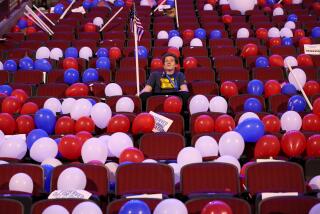Obama dominates the air as supporters work on ground
- Share via
Barack Obama’s 30-minute campaign commercial Wednesday night was not merely a tactical decision to carpet-bomb millions of Americans in pursuit of a few thousand undecided voters who can dictate the outcome of the presidential campaign.
Aired on seven network and cable stations, the ad served as a national get-out-the-vote organizing tool for Obama operatives. It offered even the swiftest channel-flipper the chance to see Obama looking presidential, helping to condition voters to that possibility. And once again it proved to John McCain, and everyone else, how Obama’s deep pool of campaign cash has allowed him to rewrite the rules of the campaign.
As the years-long pursuit entered its final days, the Democrat’s commercials were pelting important electoral states, trying to smother efforts by McCain to diminish Obama’s lead in polls of voters nationally and in most of the states likely to decide the result.
According to an accounting by the Neilsen television research company, the Illinois senator was running more than twice as many ads across the country as McCain, even after the Republican increased his television buys.
The closing days of national campaigns are usually an exercise in frustrating choices, with decisions made over which dollars can be spared for a host of competing needs. Even if a campaign decides it should make a move, financial constraints can make it impossible to pull off. Because of its wealth, Obama’s campaign has faced that dilemma less often.
On Tuesday, for example, McCain ran 1,543 ads across the nation. Obama ran 3,160, according to the Neilsen survey, and as with McCain, most were aired in Florida, Ohio and Pennsylvania.
That meant it was more than twice as easy to hear Obama’s message as McCain’s.
“At some point, the tonnage of Obama commercials makes it difficult for McCain to get his message out,” said Ken Goldstein, a University of Wisconsin-Madison political scientist who studies political advertising.
The half-hour Obama ad was a classic closing commercial, with a positive tone that belied the hand-to-hand combat going on in key states, both on the air and on the ground. He did not mention the names of his opponents, Arizona Sen. McCain and Alaska Gov. Sarah Palin, nor was there more than an elliptical reference to President Bush.
Instead, he presented himself as one who understands the fears of middle-class voters. Prominently mentioned were key electoral states, including Missouri, Ohio, New Mexico, Colorado and Florida. The film evoked Americana, opening with amber waves of grain.
McCain mocked the ad, calling it a reminder that Obama broke a promise to accept federal financing of his campaign. McCain’s dependence on federal money has left him severely constrained against Obama’s ad blitz.
“When you’re watching this gauzy, feel-good commercial, just remember that it was paid for with broken promises,” McCain said.
Obama’s words addressed a continued concern in his campaign that some voters remain unsure about his background, experience and proposals. Threaded through his policy prescriptions were references to his family background: his World War II veteran grandfather, Rosie-the-Riveter grandmother and a Midwestern-bred mother who would wake him at 4:30 a.m. for school lessons.
“In six days, we can choose an economy that rewards work and creates new jobs and fuels our prosperity, starting with the middle class,” he said at the end of the program.
The 30-minute national ad is not an original concept. A star turn in a similar commercial for Barry Goldwater in 1964 helped propel Ronald Reagan into the California governor’s office two years later. More recently, George H.W. Bush, Michael S. Dukakis and Ross Perot used extended ads. In this campaign, however, Obama was doing it alone, because he alone could afford it.
“If you have the money, you spend it,” USC political analyst Sherry Bebitch Jeffe said.
Though the program closed with a plea for votes, it served other purposes. Obama partisans held watch parties; in Los Angeles more than 100 people gathered to make thousands of phone calls to voters in Nevada, Missouri, New Mexico and Montana.
“We’re in the turnout phase of the campaign,” Democratic strategist Bill Carrick said. He said voters who watched the program might respond more positively because of the unexpected format.
“The mere fact that he’s willing to talk longer, to be on longer, gives him more credibility,” he said.
Americans may be near the saturation point when it comes to the presidential race, but the stark reality for both candidates is that the days until Nov. 4 are running down, and with them options for changing the trajectory. One of the side benefits to Obama’s media splash Wednesday was that it overshadowed McCain for the day, analysts said.
“It’s blocking out McCain,” Wisconsin advertising specialist Goldstein said. “It’s not so much about what [the ad] says good about Obama. John McCain has six days to disqualify Obama. It’s like the end of the football game and Obama is running out the clock.”
--
More to Read
Get the L.A. Times Politics newsletter
Deeply reported insights into legislation, politics and policy from Sacramento, Washington and beyond. In your inbox twice per week.
You may occasionally receive promotional content from the Los Angeles Times.











